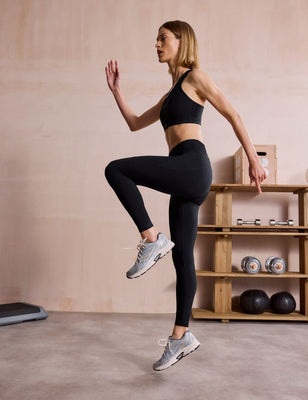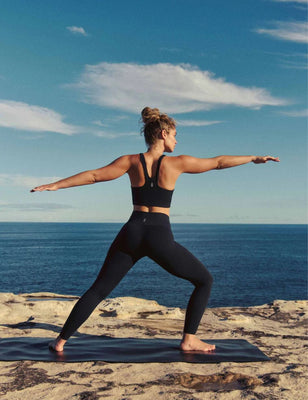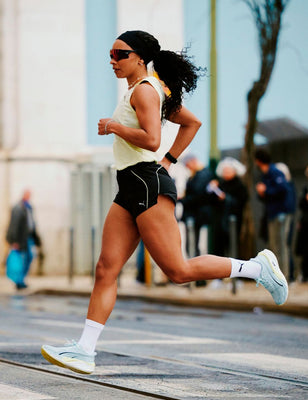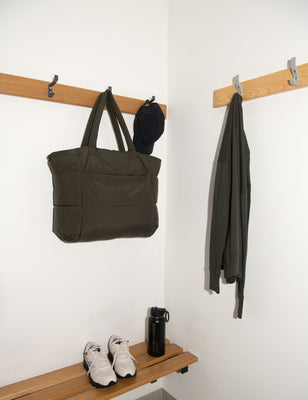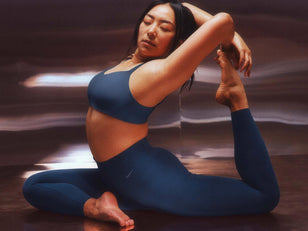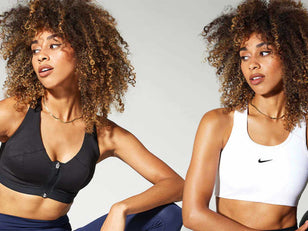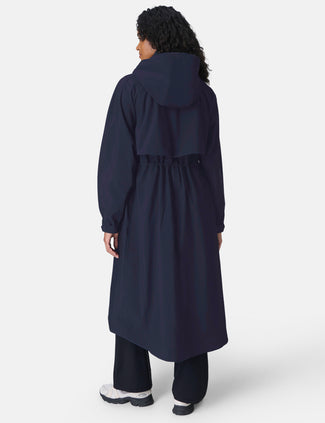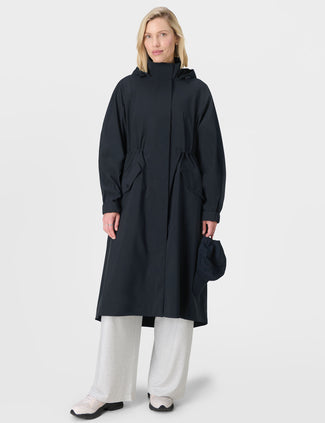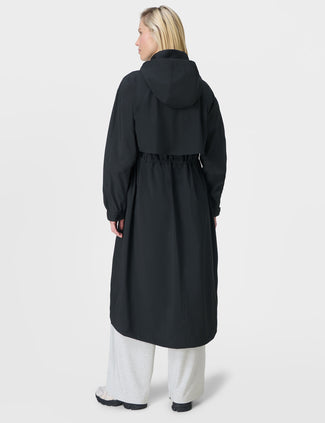Unless you’ve been living under a rock, you’ll know that the popularity of yoga has skyrocketed in recent years. Celebs like David Beckham, Jennifer Aniston and Gisele Bundchen have all raved about how regular practice has changed their lives - and their bodies.
But it’s not just the physical side of yoga that makes it arguably the perfect pastime for our age. Putting aside time to switch off and clear our thoughts feels near impossible in modern life, but for many, a regular yoga class is the ideal solution. It’s an opportunity to step away from the screen and tap into what’s going on inside, to find stillness and peace amidst hectic lives and information overload.
Where does yoga come from?
Yoga originates from ancient India, encompassing physical, mental and spiritual practises that were founded in religious texts. Nowadays many people think of yoga purely in terms of a physical exercise, but meditation and spiritualism are also at its core.
Once yoga spread to the west, countless different styles and varieties were born. Some maintain a strong emphasis on things like breath work and stillness, while others focus more heavily on the physical aspect.
What are the benefits of yoga?
- Yoga improves strength and flexibility
Whichever type of yoga you choose, many benefits remain the same. Yoga is a brilliant form of exercise for improving flexibility, tackling bad posture and building muscle strength. The poses - or asanas - all require you to use your muscles, whether it’s a high plank pose firing up your core or your shoulders actively working in a downward dog. Holding these positions and finding stillness is harder on the body than you might think - particularly if you’re new to yoga. It forces many different muscles to work at the same time to find stability, helping to tone your whole body, and particularly your core.
- How many calories does yoga burn?
While yoga is an effective form of exercise, traditional styles rank relatively low in terms of calories burned and help in terms of weight loss. But it really does depend on which style of yoga you choose. For example, you’ll burn less calories per hour in a slower, relaxing style of yoga such as Hatha compared to a dynamic or power flow:
- Hatha yoga = around 180 calories
- Vinyasa flow yoga = around 400 calories
- Power yoga = around 600 calories
But that doesn’t mean you should rule yoga out altogether if your main goal is to lose weight. You could incorporate yoga into your weekly routine as a warm-up or cool down to another form of more intense exercise like spin or HIIT. Or you could also use yoga as a form of cross training to give your body a rest.
Whatever your goals are, there is a style to suit you. And for most yogis the other benefits greatly outweigh its fat-burning potential.
- Does yoga tone your body?
In a word, yes. Holding your own bodyweight for extended periods is very effective for toning muscles. The more physical forms of yoga give you a sculpted, balanced look that is quite different to doing weights at the gym. Andy Murray has credited yoga for his strong, wiry physique. Practically everything you do in yoga is engaging your core, both poses themselves and controlled movements from pose to pose. The added bonus is that you lengthen as well as strengthen muscles.
- Yoga compliments other types of fitness
As well as building a toned body, yoga poses encourage your muscles to stretch and open up in a way many other forms of exercises do not. It’s this reason that yoga is particularly beneficial for anyone who regularly does other forms of exercise, like running. Many runners find that the more they run, the tighter they become, and this in turn can lead to injury.
So incorporating yoga into your routine is often a good way of tackling that tightness and increasing flexibility. Yoga is now regularly incorporated into the training of elite athletes, from Andy Murray to most Premier League football clubs.
- Yoga can help injuries and back pain
Yoga can also be a good option if you’re nursing an injury but still want to stay active. If you’re taking a class, the instructor will be able to recommend ways to adapt certain poses to accommodate your injury.
Yoga may also help with certain common complaints, like lower back pain. Research has found that regular practice can increase flexibility of the hips, strengthen muscles around the spine and improve posture - all factors which contribute to back pain.
However, whilst spinal flexibility and strength do help prevent back issues, some yoga postures such as forward bends, cobras and deep back bends can aggravate back pain, so definitely don’t go into a group class with an existing back condition without talking to the instructor.
Pilates is generally better for those who have existing back pain issues, as it doesn’t have the same deeper bends, and it works on spinal strength and flexibility through articulation, moving one vertebra at a time, and developing the connection between the spine and the abdominals.
If you have a back issue or injury then it is worth seeking out yoga classes designed with that in mind. Bikram studio Fierce Grace offers S.O.B sessions - stiff, old, broken - which use specially created rehabilitative poses to help stabilise and strengthen injured areas.
So the physical benefits of yoga are clear.
Can yoga have a positive effect on mental health?
Yoga is increasingly being seen as an alternative to antidepressants. While it certainly isn’t a quick fix, or a replacement for medication, research has found that practicing yoga regularly can help ease the symptoms of anxiety and depression.
By clearing your mind and focusing on the breath, yoga allows you to be present in the moment, rather than focused on past worries or future anxieties. It’s a time to slow down, take stock, and listen to our bodies. A huge part of its popularity in the recent years is that it allows people to disconnect and escape hectic modern lives.
The Sports Edit ambassador Grace Hurry, who is a qualified Pilates and Ashtanga yoga teacher, says the skills used during yoga can be applied to everyday life:
“Learning about your body, improving its strength and flexibility, and becoming aware of all the amazing things it can do is extremely empowering.”
How often should you do yoga to see the benefits?
Most people will start to see the benefits even with one good class a week, but if you can fit two classes in you will really see the effects on your strength, flexibility and overall wellbeing.
Grace recommends doing yoga every day to reap the rewards for both your physical and mental health: “Even five minutes is enough to change your mood”.
Which yoga class should I do?
With so many different types of yoga to choose from, knowing where to begin can feel daunting. Grace recommends a one-to-one session as the best way to find out what type of yoga will work for you:
“Whether it is yoga or Pilates, I always recommend that beginners have a private session before embarking on group classes. This way the teacher can recommend the best style of yoga for your goals and you can really delve deep into the fundamentals which will make your classes much more meaningful in the long term.”
So what are the different types of yoga?
Hatha yoga
The Sanskrit word hatha means ‘forceful’ and it’s actually an umbrella term for many different types of yoga. The modern day use of the word hatha refers to the physical element of yoga - the poses - and using them as a form of exercise.
In terms of classes, a hatha yoga session tends to be gentle and relaxing, with a focus on individual postures and channelling the breath into those stretches.
BEST FOR: People who are new to yoga and are starting to build up their fitness levels.
Ashtanga
One of the most popular forms of yoga, Ashtanga is a flowing practice that focuses on a set series of poses linked by movements. It’s fast-paced and energetic, with an emphasis on synchronising the breath as you move from one position into the next.
Ashtanga sequences often include traditional Hatha poses like warrior, downward dog, and high plank that will fire up the core while also giving your muscles a good stretch.
BEST FOR: People who worry they’ll find yoga boring or who want a more physical challenge.
Vinyasa yoga
This bears a lot of similarities to ashtanga, but instead of using a fixed sequence, vinyasa yoga differs each time. You’ll find the same poses in both, such as downward dog, triangle pose, warrior one and two.
This style of yoga is sometimes called ‘vinyasa flow’, because of it’s pacey, fluid movements. You also might find yourself using props in a vinyasa class, like a block or band to improve posture or to make a stretch less intense.
BEST FOR: People who want to practise flowing, fast yoga in a more relaxed atmosphere.
Bikram and hot yoga
These are two different types of yoga, but they both incorporate heat into the practice.
Bikram is a specific type of yoga founded by Bikram Choudhary which became popular in the 1970s. Classes are 90-minutes long, led by Bikram-certified teachers, and take place in studios heated from 35C to 42C.Bikram yoga includes 26 hatha yoga poses and two breathing exercises.
Similarly, hot yoga is done in a heated studio to increase the intensity and encourage muscles to stretch. But unlike Bikram, it is not a set practice, and the type of yoga will vary from studio to studio.
While hot yoga is becoming more popular, some people may find the heat overwhelming and that it causes them to overstretch. A good way to get started with hot yoga is to find a studio offering classes at lower temperatures.
BEST FOR: People who want to experience a more intense workout and leave with a healthy glow.
With hot yoga it is particularly important to find the right studio for you, so have a read of our review of the Top 7 hot yoga studios in London.
Power yoga
Moving away from the traditional principles of yoga, this style puts an emphasis on building strength and fitness rather than meditation.
Power Yoga first began in America as a way of making yoga a more physically demanding form of exercise. There are no set poses, which means instructors can be more flexible in which postures they choose to focus on and even create their own.
Best for: People wanting to burn calories, while improving strength and fitness.
Yin yoga
Feel the need to slow things down? Then this may be for you.
In a yin yoga practice, you’re encouraged to hold the poses for longer, channelling your breath into the body and becoming aware of how it feels. Those who are new to yin will generally hold positions for 45 seconds to two minutes, while more experienced yogis can stay in a pose for up to five minutes or more.
Best for: People with lower levels of fitness who want to increase circulation in their joints and improve flexibility.
Restorative yoga
Another way to slow down and relax is by taking a restorative yoga class. It will open up your body without putting stress on your muscles and joints. By using props like a wall, blocks or blankets, it allows for passive stretching and a way of easing gradually into the different positions.
Classes typically only feature five or six restorative poses, but they are held for five minutes or more to allow the body to become still and relax.
BEST FOR: People nursing injuries or lacking flexibility, who want to experience the benefits of yoga.
Kundalini yoga
This style is all about unlocking energy within the body, using meditation and yogic breathing to find a deeper awareness of spirit and mind. Kundalini focuses heavily on inner feelings - rather than physical ones - and can be practised anywhere, by anyone, regardless of fitness or age.
Practices usually centre around three main tools - chanting, breath work and physical postures. These poses tend to focus on your stomach, lower back and different pressure points to release your inner Kundalini energy.
BEST FOR: People looking for internal benefits and tools to tap into their spirituality.
Iyengar yoga
Founded by B.K.S Iyengar in the 1970s, this style is growing in the UK. It puts emphasis on postural alignment, focusing on hatha poses and making sure they are performed correctly.
The idea is that by concentrating on form and breathing, practicing iyengar yoga can help alleviate pain caused by bad posture, relieve tension on the joints and give you a better understanding of your body.
Classes often include standing postures and more specialised movements like backbends and inversions.
BEST FOR: People suffering with poor posture or alignment.
What is the difference between yoga and Pilates?
So we’ve talked about all the different varieties of yoga - but what about Pilates?
Often Pilates and yoga are talked about in the same vein, and while there are similarities, they’re different forms of exercise.
“Unlike yoga, Pilates is not a spiritual practice,” explains our ambassador Grace Hurry (pictured above). “Although Pilates can often feel like a moving meditation when you have been practicing for a while.”
Pilates is far more focused on the physical aspect of exercise, using a combination of flowing moves to tone muscles and build strength.
Mat Pilates as you might guess, is based on an exercise mat and sometimes incorporates equipment like small exercise balls, resistance bands and Pilates rings.
While Reformer Pilates is traditionally done using large machines that have springs and pulleys to create resistance.
However the poses in yoga and Pilates are not entirely exclusive, as Grace notes some yoga poses have been adopted into Pilates:
“Joseph Pilates did create the mat-based Pilates repertoire that has some similarities to certain yoga postures, like navasana - boat pose.”
Should I choose to do yoga or Pilates?
While some people choose to practice one or the other, other people increasingly incorporate both into their fitness regime.
When it comes to the benefits of Pilates versus yoga, Grace says it’s hard to pinpoint specifics. Though as we said earlier, Pilates does have advantages if your focus is specifically on addressing back pain.
Both yoga and Pilates help build toned, lean muscles, a strong core, and improve flexibility. And while yoga and spirituality go hand-in-hand, doing any form of exercise can be hugely effective in terms of keeping good mental health.
Grace explains: “My mentor, Rael Isacowitz often says, ‘Pilates is for anyone, but not for every body’ which I completely agree with. The most important thing is to find a form of exercise that you enjoy, and that way you will stick to it. Then the physical and mental health benefits will follow depending on the style of yoga or Pilates that they have fallen in love with.”
The most important thing is to find a form of exercise you enjoy... then the physical and mental health benefits will follow
Grace Hurry
What are the best yoga studios?
Whilst the likes of Frame, Another Space and most of the leading London fitness studios have decent yoga classes, it's the specialist studios that are our go-to.
Here are 8 of London's best studios:










